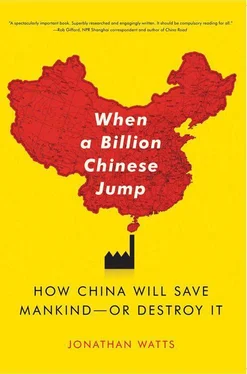61. Song Weiming, Chen Baodong, Zhang Shengdong, and Meng Xianggang, “Russian Logs in China: The Softwood Commodity Chain and Economic Development in China,” Beijing Forestry University, Forest Trends and Rights and Resources, www.forest-trends.org, 2007.
62. Ibid.
63. Some of the wood products are processed and reexported in the form of furniture and flooring to Europe, the U.S., and Japan, but eight out of every ten Siberian logs that come into China are used in the domestic market, mostly for construction (ibid.).
64. Ibid.
65. My thanks to Mary Hennock for this information.
66. Song et al., “Russian Logs in China.”
67. China’s 2,531 protected areas cover 15.2 percent of the country, well above the international average and more than four times higher than the U.S. wetland reserves cover of 14.5 million hectares (MacKinnon and Wang, The Green Gold of China, p. 282).
68. The reserves are usually divided into three zones. The inner core is supposed to be completely off-limits to hunting, logging, building, or any kind of development. The middle ring is for scattered farming and the outer “experimental zone” is for limited economic activity.
69. “At least two to three swans are poisoned every day in Poyang Lake,” Jiangnan Urban News, January 5, 2009, www.jfdaily.com/news/xwgn/200901/t20090112_505791.htm.
70. Although, as she also pointed out, there are occasional acts of great courage. Confronting poachers can be dangerous because their lives as well as their livelihoods can be at stake. Those caught hunting the rarest animals face a possible death sentence. Shortly before we arrived in Heilongjiang, a People’s Liberation Army officer based in the province was awarded a conservation prize for his work in removing traps set by poachers despite death threats and occasional beatings.
71. Mr. Hu and Mr. Wen are by no means the first politburo and government leaders to advocate a sustainable model of growth, but China’s modern history does not offer much cause to be optimistic about their policy of “Scientific Development.”
72. Cited in Ma, China’s Water Crisis, p. 124.
73. As the Environment Protection Agency, its representatives could participate in cabinet meetings only as observers. That changed when ministerial status was attained.
74. The ministry has a budget of just over $10 billion per year and just 300 staff at state level, compared with 9,000 who work in the U.S. Environmental Protection Agency in Washington (Elizabeth Economy, The River Runs Black: The Environmental Challenge to China’s Future [Cornell University Press, 2004]). Many of China’s 2,400 regional environmental protection agencies are revenue-generating. In most cases, companies can get away with polluting rivers and the air by paying a fee to the local environmental bureaus. “When the local governments require some new funds, they can go on inspection tours of local companies,” he says. “And when they come back, they have their coffers filled.” Elizabeth Economy says companies whose emissions have generated complaints are merely charged higher fees.
75. Professor Wang Canfa at China University of Political Science and Law (Xinhua, “China Improves Enforcement of Environmental Laws,” June 10, 2005).
76. Local officials frequently divert environmental protection funds and spend them on unrelated or ancillary endeavors. The Chinese Academy for Environmental Planning, which reports to SEPA, disclosed in 2009 that only half of the 1.3 percent of the country’s annual GDP dedicated to environmental protection between 2001 and 2005 had found its way to legitimate projects. According to the study, about 60 percent of the environmental protection funds spent in urban areas during that period went into the creation of, among other things, parks, factory production lines, gas stations, and sewage-treatment plants rather than into waste-or wastewater-treatment facilities (Elizabeth Economy, “The Great Leap Backward?” Foreign Affairs, September/October 2007).
77. The information disclosure law has helped in many regards, but there are still big gaps. The sensitivity of environmental information became evident when the Chinese government asked the World Bank to remove an estimate of the deaths caused by pollution in a joint report (“China Must Come Clean About Its Poisonous Environment,” Financial Times, July 3, 2007). According to Guo Xiaomin, a former official with the Chinese State Environmental Protection Agency who managed the report’s mainland researchers, the information was officially excluded from initial drafts of the report owing to reliability concerns and because of fears that its inclusion would make the report too bulky. However, Guo also admitted that there were concerns that the Chinese public would react badly upon learning about the true extent of pollution-related deaths.
78. Pan advocated a Chinese form of socialist environmentalism, centered on social justice but borrowing heavily from Western ideas of sustainable development, environmental protection, preservation of resources, and ecological balance. More than technological change, he believed “Scientific Development” was a change of politics, economics, culture, and society. (Pan Yue, “On Socialist Environmentalism,” China Economic Times, September 26, 2006. Comments also taken from an interview with Zhou Jigang translated and published by China Dialogue. )
79. His replacement in the key post of deputy environment minister was a former member of the Yunnan provincial government, the biggest supporter of a huge hydroelectric scheme due for review (Jonathan Watts, “China’s Green Champion Sidelined,” Guardian, March 12, 2009).
80. Pan had previously used his power to great effect. In December 2004, the State Environmental Protection Agency suspended the construction of about thirty large projects because they had not undergone the environmental impact assessment required by law. Though some were worth more than a billion dollars, the culprits were named, shamed, and halted. The domestic media described this unprecedented assertion of environmental regulations as “storm” tactics.
81. Offenders are protected by the vast majority of local authorities that defy Beijing and violate state law by refusing to disclose information about pollution. One study found that just 4 out of 113 local governments complied (Jonathan Watts, “Local Governments Keep Chinese Public in the Dark about Pollution,” Guardian, September 4, 2009).
82. After deadly floods in 1998 were blamed on the deforestation of hillsides, Zhu introduced restrictions of logging in Heilongjiang, Yunnan, and many other areas.
83. The commentator Liang Jiang goes further, suggesting bureaucrats increase waste because it expands their empires (Liang Jiang, “How Is the World to Deal with China’s Lack of Fear of Waste?” August 9, 2009 [in Chinese]).
84. The initial Asian Development Bank grant was canceled after government ministries and northeastern provinces fought each other to secure a share of the budget. A new, more focused research and conservation project is now under way, but despite the construction of a smart new headquarters for the reserve staff, the Sanjiang wetlands have been steadily opened up to agricultural development.
85. The national situation is even more worrying. The northern province of Hebei has lost 90 percent of its wetlands over the last fifty years; 80 percent of what is left is polluted. In Shaanxi Province the thirty counties in the Guanzhong area have seen up to 10,000 ponds disappear. Poyang Lake, China’s largest freshwater lake, now shrinks to an area as small as 50 square kilometers, down from 4,000 at its peak. The loss of wetlands has meant aridity spreading from the north to the country’s fertile south. In 2007, tens of millions of people living around Poyang Lake suffered drinking water shortages. Wetlands in arid and semiarid regions are not faring any better. Alashan, in Inner Mongolia, is seeing wetlands dry up due to water abstraction from the Hei River upstream. Water flowing into this traditionally green area has dropped from 900 million cubic meters to 200 million, leading to the disappearance of hundreds of lakes and ponds. The creation of new farmland around the upper reaches of the Tarim River, in the Xinjiang Autonomous Region, has led to a 350-kilometer stretch of the river drying up, with deserts appearing where lakes once were. (Jiang Gao-ming, “China’s Evaporating Wetlands,” China Dialogue website, August 28, 2008). The Haihe, the biggest wetland system in northern (as distinct from northwestern) China, has seen four-fifths of its wetlands disappear as water is sucked away by megacities such as Beijing and Tianjin (Jonathan Watts, “Wetlands Sucked Dry in China,” Guardian, February 13, 2006).
Читать дальше










